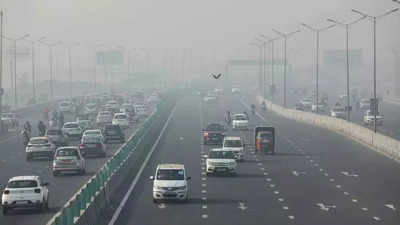- News
- City News
- delhi News
- Even rare days when air meets our standards not good enough
Trending
Even rare days when air meets our standards not good enough
Experts urge revisiting air quality management strategies, enforcing stricter standards, and addressing local pollution sources to save lives in India, as highlighted by a recent study in Lancet Planetary Health.

The study noted that in 10 cities — Ahmedabad, Bengaluru, Chennai, Delhi, Hyderabad, Kolkata, Mumbai, Pune, Shimla and Varanasi — around 33,000 deaths per year can be attributed to air pollution that are above the WHO guidelines of 15 micrograms per cubic metre.Of these, Delhi had the highest toll of around 12,000 deaths annually during the study period. The study, therefore, recommends that the Indian air quality standards should be made more stringent and efforts to check air pollution redoubled.

For the study, the researchers used data on PM2.5 exposure in the 10 cities and daily mortality count between 2008 and 2019. The study was conducted by researchers from academic institutions in India (Sustainable Futures Collaborative, Ashoka University, Centre for Chronic Disease Control), Sweden (Karolinska Institutet) and USA (Harvard University, Boston University).
“During the study period, 7.2% of all deaths (33,000 each year) in the 10 cities could be linked to short-term PM2.5 exposure higher than the WHO guideline value of 15 micrograms per cubic metre,” the study says. Delhi had the highest proportion at 11.5% of the deaths, while Shimla had the lowest at 3.7%, or 59 deaths annually between 2008 and 2019.
The study observed that for every 10 micrograms per cubic metre increase in the average PM2.5 exposure over a two-day period, the daily mortality across the 10 cities increased 1.4%. However, this estimate nearly doubled to 3.6% when researchers used a causal modelling approach that isolated the impact of local sources of air pollution. This causal analysis highlighted the need for greater attention on the numerous dispersed sources of local air pollution across cities, including transport and waste burning.
The research said that current policy instruments such as Graded Response Action Plans largely focused on pollution extremes and had to be recalibrated to focus on year-round action.
“This study demonstrates for the first time how the risk of mortality is significant even at lower levels of air pollution,” pointed out Poornima Prabhakaran, director, Centre for Health Analytics Research and Trends, Trivedi School of Biosciences, Ashoka University, and India lead of CHAIR-India consortium. “The insights signal an urgent need to revisit our air quality management strategies that currently focus only on ‘non-attainment cities’, rethink current air quality standards and shift from addressing regional to local sources to effectively protect human health.”
In a similar tone, professor Joel Schwartz of Harvard University, co-author of the study, reiterated, “Lowering and enforcing Indian air quality standards will save tens of thousands of lives per year. Methods to control pollution urgently need to be applied in India.”
Bhargav Krishna, fellow at the Sustainable Futures Collaborative and lead author of the study, said, “The results of this multi-city study show us that reducing air pollution is a nationwide challenge. Our analyses highlight air pollution’s substantial effect on mortality even in cities previously considered less polluted such as Mumbai, Bengaluru, Kolkata and Chennai. The significant effects observed below the current Indian standards have implications for what we consider acceptable air quality.”
Fellow lead author Jeroen de Bont, postdoctoral researcher at Karolinska Institutet, said that it was crucial to address dispersed local sources of pollution alongside existing anti-pollution strategies.
End of Article
FOLLOW US ON SOCIAL MEDIA










